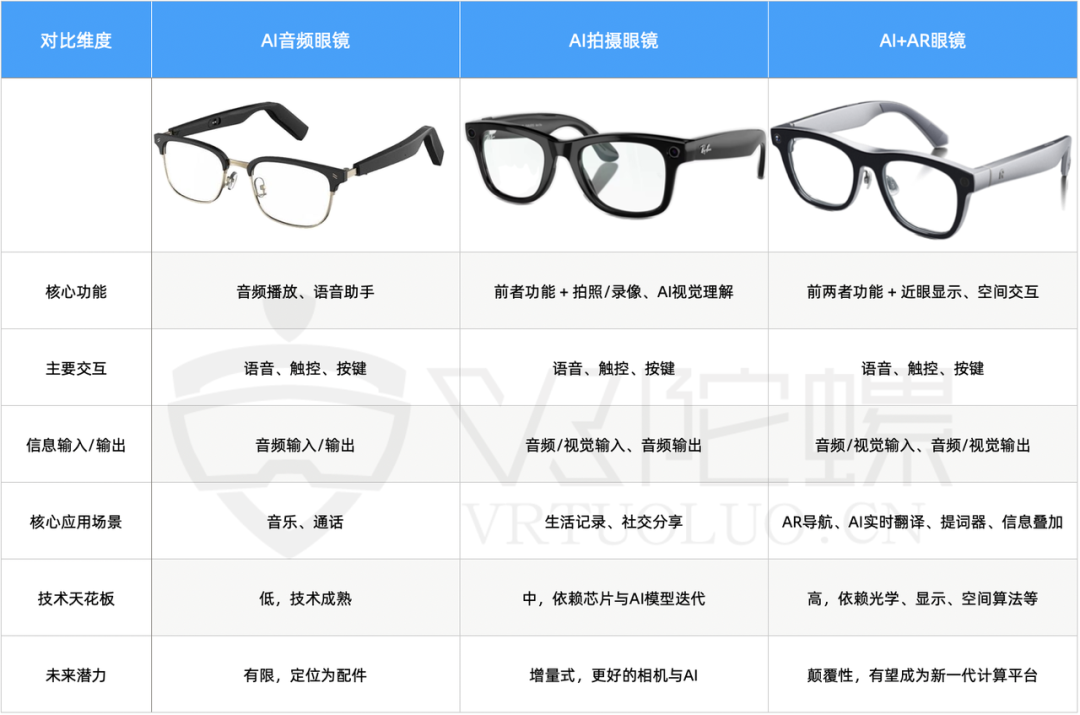Rokid Glasses Debuts: "Visible AI" Redefines the Future of AI Glasses
![]() 07/07 2025
07/07 2025
![]() 561
561
Text/VR Gyroscope, Ran Qixing
With the recent launch of Xiaomi's AI glasses, the tech industry has been invigorated, propelling the competition for the next generation of personal smart devices to new heights. Leveraging its robust brand and market influence, Xiaomi has successfully introduced the slightly avant-garde category of AI glasses to the Chinese market.
Amidst this intense competition from industry giants, a "phenomenal product" has also made its presence felt. Rokid, a leading AR manufacturer, has officially released its groundbreaking product, Rokid Glasses, to the first batch of F-code users. These are the same AR glasses that garnered significant online buzz earlier this year.
Unlike Xiaomi's AI glasses, which share similarities with Ray-Ban Meta, Rokid Glasses not only incorporate fundamental capabilities such as photography, audio, and AI multimodal interaction but also feature a state-of-the-art near-eye display optical system utilizing Micro-LED + Diffractive Light Waveguide technology. This makes them an advanced iteration of "AI+AR glasses." This "visible screen" might seem like a mere additional display module but actually signifies two vastly different product philosophies and technological pathways.

Rokid Glasses Unveiled: Navigating the Product's Philosophy Through "AR Navigation"
For any AR glasses, "being visible" is just the beginning; "being comfortable and efficient to see" is the true litmus test for the product's capabilities. Among the feedback from the initial batch of Rokid Glasses users, "AR navigation" emerged as a key application scenario.
Imagine navigating a complex urban interchange or biking along a scenic route. Instead of constantly glancing down at your phone or dashboard, real-time, crystal-clear turn arrows, speed, distance information, and route guidance float naturally in front of your vision.
This is the future that Rokid Glasses showcases. Combining real-life AR navigation videos with users' initial hands-on experiences, we can clearly see the unique AR effect of Rokid Glasses. Compared to simple audio instructions like "turn left ahead," the AI voice + "AR-HUD" navigation system offers an overwhelming amount of precise information, aligning more closely with human sensory cognition logic of "audio-visual coordination."

Furthermore, Rokid Glasses' AR UI design is noteworthy for its humanized controls—all navigation information is cleverly positioned directly below the user's field of vision. The bottom of the view is a typical non-core visual area, while non-core but essential information such as battery level and Bluetooth connection status is placed in the top-right corner.
This design maximizes the user's main view (especially critical forward visibility while driving or biking) to remain unobstructed, ensuring safety in various scenarios. Information is an aid, and people are the focus. This "people-centric" product design philosophy permeates the entire software and hardware design of Rokid Glasses. Only by prioritizing the consumer's perspective can an exceptional C-end product be created.
Of course, AR navigation is just one facet of Rokid Glasses' diverse application scenarios. Whether it's real-time translation with text appearing next to the speaker or previewing teleprompter messages without breaking eye contact, "display" remains the core. Without an AR near-eye display system, no matter how powerful AI becomes, it remains confined to the dimensions of "listening" and "speaking," unable to truly enhance visual experiences.
Near-Eye Display Optics: The Technological Turning Point for AI Glasses
Currently, the AI glasses market has evolved into a tripartite product landscape: pure AI audio glasses, AI camera glasses represented by Meta and Xiaomi, and AI+AR glasses spearheaded by Rokid. Each type of product has its market value and technological advantages.
However, in the long run, considering the inevitable trajectory of technological evolution, AI+AR glasses with display capabilities are undoubtedly the "ultimate form" and future direction of AI glasses. "Seeing" is the most efficient way for humans to acquire information, providing AI with a visual channel to interact with users. Near-eye display optics is indeed a technological turning point for AI glasses.
As an AR innovator with a decade-long pursuit of its dreams, Rokid has chosen the most challenging path but also the one with the highest potential, representing technology that truly wows users.

To enable users to "see" AI, Rokid Glasses integrates an exceptionally complex optical system within tiny lenses. Its core technology stack employs the Micro-LED + Diffractive Light Waveguide solution, recognized by the industry as the "ultimate solution" for consumer-grade AR.
In simple terms, Micro-LED, a new type of miniaturized, high-brightness display technology, primarily serves as the light source for generating images. Diffractive Light Waveguide acts as a "light carrier," diffracting and coupling out the light emitted by Micro-LED through an extremely precise grating structure, ultimately projecting it into the human eye. The significant advantage of this solution is that it allows AR glasses to maintain high lens transmittance and a slim form factor, creating an AR glasses product resembling ordinary glasses, providing users with a more comfortable wearing experience.
However, this highly anticipated technology combination is also the industry's biggest bottleneck. Both the manufacturing process of Micro-LED and the nanometer-scale grating manufacturing of Diffractive Light Waveguide face extremely high technical hurdles, leading to low yield rates and high costs.
Against this backdrop, Rokid struck a balance between product and technology, adopting a "one-to-two" single light engine binocular display solution. By utilizing a single Micro-LED light engine, it achieves binocular display and reduces the BOM cost by nearly half. This strategic "balance" allows Rokid to bring AI+AR glasses equipped with cutting-edge optical technology to consumers at a relatively "affordable" market price.
From "Novelty" to "Common Use": AR Glasses Still Require Patience
Admittedly, the path to any cutting-edge technology is fraught with challenges. Currently, even innovative products like Rokid Glasses face industry-wide "impossible triangles" and hurdles. For instance, while Diffractive Light Waveguide technology offers extreme thinness and lightness, it may also be accompanied by optical flaws such as "rainbow patterns," failing to achieve perfect visual purity.
The conflict between weight and battery life remains prominent. Despite Rokid Glasses employing the Snapdragon AR1, a dedicated AR glasses chip with relatively low power consumption, prolonged high-brightness operation still significantly drains the battery. After all, the valuable space within AR glasses' temples cannot accommodate a large battery like a smartphone; the primary concern of glasses is still to provide a comfortable wearing experience.
These technical challenges have plagued the AR industry for years, but we witness progress every year. Comparing Google Glass from 13 years ago to today's Rokid Glasses represents a complete revolution in optical technology and comprehensive product form optimization, aiming to further penetrate the consumer market.
In Rokid Glasses, we also see the maturity of application functions such as AI translation, AR navigation, teleprompter, and AI multimodal interaction, reaching a state of true usability and implementation. Consumer-grade AR glasses are indeed accelerating their integration into our lives and the market.

History tells us that for industries with high technological content, it requires countless technological advancements and experience accumulations to achieve qualitative change from quantitative change. This is an inevitable stage in technological evolution. The market's maturity demands patience and inclusivity.
Regardless, we eagerly anticipate more Rokid Glasses, continuously exploring cutting-edge technology and showcasing captivating application scenarios, just as demonstrated by today's "AR navigation."








